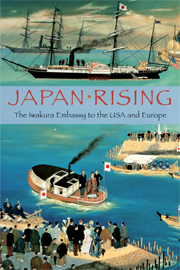Book contents
- Frontmatter
- Contents
- Introduction by Ian Nish
- Note on the Text
- VOLUME I THE UNITED STATES OF AMERICA
- Preface
- 1 The Voyage across the Pacific
- 2 A Survey of the United States of America
- 3 A Record of San Francisco, 1
- 4 A Record of San Francisco, 2
- 5 The Railroad Journey in the State of California
- 6 The Railroad Journey in the State of Nevada and Utah Territory
- 7 The Rocky Mountain Railroad
- 8 The Chicago Railroad
- 9 The Railroad Journey from Chicago to Washington, D.C.
- 10 A Survey of the District of Columbia
- 11 A Record of Washington, D.C., 1
- 12 A Record of Washington, D.C., 2
- 13 A Record of Washington, D.C., 3
- 14 The Journey Through the Northern States, 1
- 15 The Journey Through the Northern States, 2
- 16 The Journey Through the Northern States, 3
- 17 A Record of Washington, D.C.: Epilogue
- 18 A Record of Philadelphia
- 19 A Record of New York City
- 20 A Record of Boston
- VOLUME II BRITAIN
- VOLUME III CONTINENTAL EUROPE, 1
- VOLUME IV CONTINENTAL EUROPE, 2
- VOLUME V CONTINENTAL EUROPE, 3; AND THE VOYAGE HOME
- Index
10 - A Survey of the District of Columbia
Published online by Cambridge University Press: 04 August 2010
- Frontmatter
- Contents
- Introduction by Ian Nish
- Note on the Text
- VOLUME I THE UNITED STATES OF AMERICA
- Preface
- 1 The Voyage across the Pacific
- 2 A Survey of the United States of America
- 3 A Record of San Francisco, 1
- 4 A Record of San Francisco, 2
- 5 The Railroad Journey in the State of California
- 6 The Railroad Journey in the State of Nevada and Utah Territory
- 7 The Rocky Mountain Railroad
- 8 The Chicago Railroad
- 9 The Railroad Journey from Chicago to Washington, D.C.
- 10 A Survey of the District of Columbia
- 11 A Record of Washington, D.C., 1
- 12 A Record of Washington, D.C., 2
- 13 A Record of Washington, D.C., 3
- 14 The Journey Through the Northern States, 1
- 15 The Journey Through the Northern States, 2
- 16 The Journey Through the Northern States, 3
- 17 A Record of Washington, D.C.: Epilogue
- 18 A Record of Philadelphia
- 19 A Record of New York City
- 20 A Record of Boston
- VOLUME II BRITAIN
- VOLUME III CONTINENTAL EUROPE, 1
- VOLUME IV CONTINENTAL EUROPE, 2
- VOLUME V CONTINENTAL EUROPE, 3; AND THE VOYAGE HOME
- Index
Summary
The city of Washington is the capital of the union of thirty-seven states and forms an independent region known as the District of Columbia.
In upholding their pledge of confederation, the present thirty-seven states confer among themselves, obey federal laws and regulations, collect and transmit taxes, nominate and elect a joint chief executive, and support a single national government. The federal government is thus the locus of the Constitution and of the laws of the land. It governs the land and the people of all the states. There is no absolute need for the central government to possess land or people of its own. However, for the government to have to reside on a temporary basis in one of the states would be inappropriate. Having agreed upon a federal government, the states eventually decided to allot land on which to locate their government. The District of Columbia was created after the government had been established, just as West Point was founded after the system of military academies had been set up.
Before the government was settled in the District of Columbia [in 1790], there was no established capital. After the original thirteen colonies rejected British rule and established an independent confederation, there were long and bitter debates [over the rights of the states versus the claims of the central government and over the location of a capital].
- Type
- Chapter
- Information
- Japan RisingThe Iwakura Embassy to the USA and Europe, pp. 55 - 57Publisher: Cambridge University PressPrint publication year: 2009



